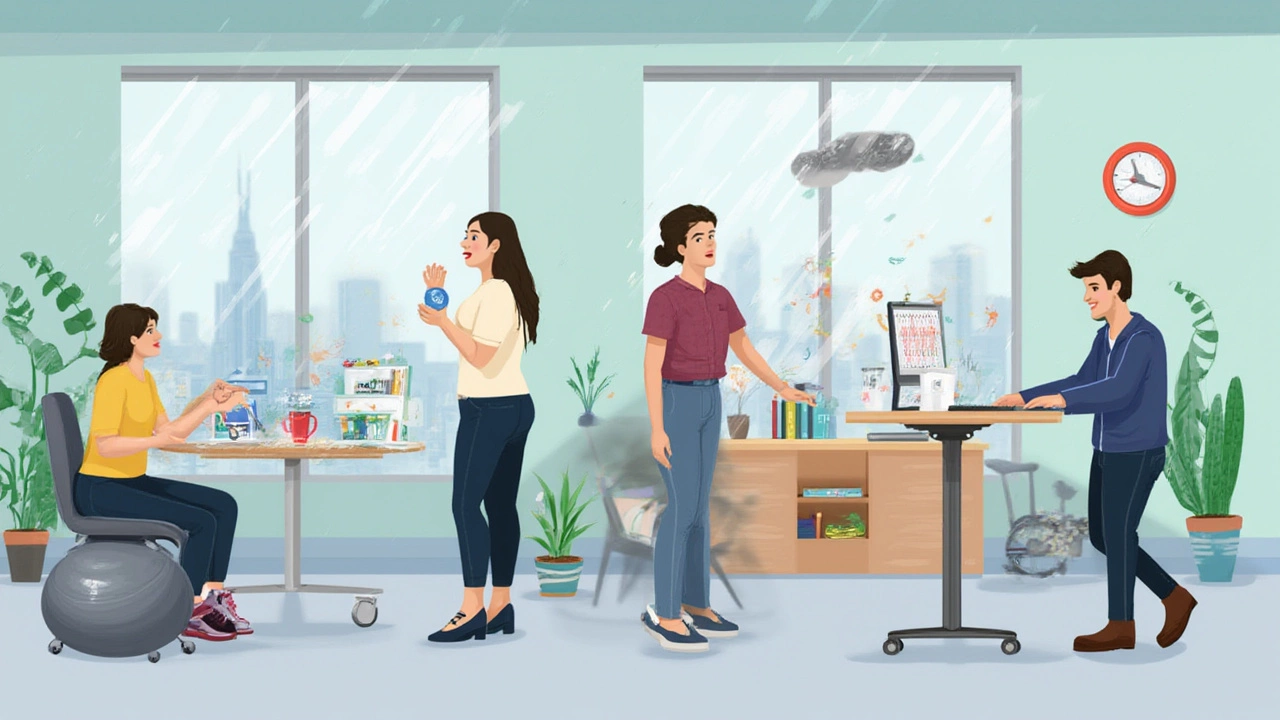If you’ve ever tried to sit through a meeting, a school lesson, or dinner with someone who’s got ADHD, you know their energy can light up the place—or make you wonder if they’ve got an itchy seat. Drumming fingers, bouncing knees, changing positions every five minutes, falling off chairs on purpose (yes, it happens)—it often looks like they can’t help it, because, well, they really can’t. So why can’t people with ADHD sit like everyone expects them to? The answer knocks right at the door of brain wiring, the mechanics of dopamine, and a body constantly looking for something to do. This isn’t a lack of manners, it’s a glimpse into a different operating system.
Breaking Down Why Sitting Still is So Hard
Let’s start with the elephant in the room: people with ADHD don’t fidget just because they’re bored or misbehaving. If anything, research from the University of Cambridge found that when kids with ADHD are required to sit completely still, their ability to focus drops sharply. It’s almost like their brain uses movement as an anchor. The official reason ties back to how the ADHD brain handles dopamine, a chemical messenger that’s key to feeling motivated and alert. When dopamine’s in short supply, the brain craves stimulation—movement, fidgeting, pacing—anything to boost that chemical and help with focus.
One 2023 study out of Denmark showed that over 80% of kids diagnosed with ADHD physically can’t stay still for long. You’ll often see them squirm, stretch, tap things, or tilt back on chairs. School teachers have noticed this for years, and it’s more than just a classroom nuisance—it’s biological. The same loop plays out for adults with ADHD, too. Desks, conference tables, or bus seats don’t magically cure restlessness once you grow up. In fact, adults often invent their own ways to channel the extra energy, like bouncing feet, clicking pens, or even going for a walk mid-task.
And it isn’t just about ‘getting comfy’ either. Restlessness in ADHD is internal—think of it as if your mind is straining at the leash, and you need to physically move to give it some slack. People describe the sensation like a buzzing, a pressure they need to let out just to function. If you try to clamp down on the movement—say, you force a kid with ADHD to fold their hands and keep quiet for long—you’ll likely see the opposite effect: worse concentration, more frustration, and sometimes a total emotional meltdown. The oldest trick in the book ("Can’t you just sit still for one minute?") usually backfires.
Now, there are even differences in the way bodies process signals. Imaging scans—like fMRI—have shown that brain circuits in people with ADHD run on different tracks compared to neurotypical folks. Parts of the brain responsible for planning, controlling impulses, and switching focus are a bit like a cyclist riding on a gravel path: wobbly, needing little course adjustments. That means sitting still might not just feel hard—it can feel impossible without some allowance for wriggling.
| ADHD Statistic | Detail |
|---|---|
| % of kids with ADHD who move constantly | 82% |
| Increase in focus when allowed to fidget | 23% (Cambridge study) |
| Adults with reported workplace restlessness | 67% |
| Dopamine production compared to typical brains | 20% less |
| Classrooms using alternative seating (UK, 2024) | 17% |
The numbers paint a pretty clear picture: sitting still just isn’t how the ADHD brain works best. If a person with ADHD slouches in their chair or rocks on their toes, it’s usually not a rebellious move—it’s literally helping them cope. So next time you see someone unable to resist shifting in their seat, you’ll know there’s a powerful brain chemistry reason behind it.

How Fidgeting Works: Movement as a Focus Tool
Here’s something a lot of people get wrong: fidgeting isn’t just a side effect of ADHD, it’s often a makeshift brain hack for getting stuff done. People with ADHD move because it actually helps them listen, follow a conversation, or get through a boring activity. This isn’t simply anecdotal—real data backs it up. One 2022 experiment in Manchester schools gave kids small squeeze balls to use quietly at their desks. Their teachers reported a surprising jump in attention and fewer classroom disruptions. Basically, when their bodies get to move, their brains work better.
The science is clever here. When you fidget—be it tapping, doodling, standing, or kneeling on chairs—your brain gets a jolt of stimulation. That stimulation can temporarily raise dopamine, making you feel more alert and organised. It’s like topping off a battery that drains too fast. Without it, the brain starts looking for something exciting to do (which is why daydreaming or zoning out happens). Fidgeting, then, isn’t the enemy of focus; it’s a weird ally.
Not every kind of movement works the same. Quick, rhythmic motions like bouncing a knee or spinning a pen seem to be most effective, probably because they’re repetitive and almost automatic. They don’t take up a ton of attention, so the person can still concentrate on what’s happening in class, at work, or around the dinner table. More dramatic movements—like getting up and pacing—are usually signs that the mind is veering into frustration territory, not just coping. People often don’t realise it, but for many, being told to stop fidgeting can be as disruptive as losing your place in a conversation.
This is why lots of places are quietly changing how things are done. British companies have started testing standing desks, wobble stools, and fidget-friendly conference rooms with stress balls and textured mats under the table. Even public libraries in Birmingham have “wiggle seats” for visitors with ADHD—imagine asking for something to help you focus rather than being told off for squirming. The message is clear: if fidgets help someone pay attention, they’re not a quirk to ignore. They’re a support tool.
Curious about what works? Here are some favourite movement tricks people (both kids and adults) swear by:
- Chewing gum or sucking mints (helps stimulate the mouth, weirdly calming for the brain)
- Using stretchy rubber bands under desks as footrests
- Playing with textured hand toys (stress balls, putty, or little cubes)
- Bouncing on therapy balls or sitting on wobbly cushions while working
- Walking meetings or voice notes on the go, so movement and talking go hand-in-hand
What’s important is the why behind these strategies. The aim isn’t to squash movement, but to use it purposefully, so the mind doesn’t wander off or burn out. And yes, sometimes you’ll get weird looks or the occasional joke ("Can’t you sit like a normal person?") but for people with ADHD, fidgeting is as essential as breathing—just a lot noisier.

What Can Help: Realistic Tips for ADHD Sitting Challenges
If you or someone you know lives with ADHD’s unique brand of restlessness, there’s good news: you don’t have to battle your chair every day. Small, tactical changes make a huge difference when sitting still feels impossible. It’s all about working smarter—not wrestling your body into submission.
Start with the environment. Flexible seating is making its way into schools, offices, and even homes. Swap stiff wooden chairs for yoga balls, posture-support cushions, or stools that rock gently. These options keep your core engaged and allow safe movement without distracting everyone else. In one Birmingham primary, simply bringing in balance boards as footrests led to happier students—and the teaching staff stopped nagging kids for not sitting up straight.
If movement helps, build in official fidget time. Quick stretch breaks between lessons or long meetings can refresh the body and mind—think jumping jacks, a dash up the stairs, or dancing for thirty seconds. Adults find that walking while thinking, pacing on calls, or switching rooms to brainstorm ideas stops their focus from unravelling. Physical reminders work: setting a timer for regular movement, or using smartwatches that buzz every half hour, keeps bodies moving and brains sharp.
Hands need something to do? Keep quiet fidgets handy. Chewable pencil toppers, fidget cubes, or even fiddling with a paperclip can do the trick. It helps to let teachers, bosses, or family members in on your secret weapon—so they know that your squirming is a tactic, not an attitude. Sometimes it’s about compromise: "I’ll keep my feet tapping as long as I don’t talk out of turn" tends to work in a pinch.
Parents and caregivers can get creative. Instead of "sit still and listen," try "Can you wiggle your fingers quietly while I read this bit?" Schools that support movement report better engagement—not just for kids with ADHD, but for the rest of the class too. Adults at home might use standing desks or swap out the dining chair for a wobbly stool on tired days. Simple tools help: weighted lap pads, resistance bands on chair legs, or music that sets a steady rhythm.
Of course, there’s a learning curve. Finding what works means asking real questions: Do I concentrate better when moving? Which fidgets cause a fuss, and which slip under the radar? Some days you might need a full walk outside; others, just a subtle stretch under the desk. Tracking focus and energy throughout the day—jotting a quick note after each change—helps figure out when and why movement boosts (or disrupts) focus.
And don’t forget the role of technology. There are focused apps built just for ADHD brains—breaking tasks into small sprints with regular built-in breaks. Smart lamp bulbs that flash after 20 minutes, or lively playlists tailored to match focus rhythms, turn the old "sit and suffer" approach upside down. Some Birmingham businesses even offer tech-assisted "focus pods"—soundproof cubicles where you can hop on a treadmill or spin bike while working on your laptop. Now we’re talking!
Look, it all boils down to understanding. People with ADHD aren’t challenging the norm just for laughs—they’re quite literally wired to move. The more you can accept that—and even embrace it—the easier life gets. If fidgeting means you or your kid gets homework done in half the time, or you ace that Monday morning meeting, go ahead and tap away. You’re working with your brain, not against it. That’s not just smart, it’s the ADHD way.


Write a comment